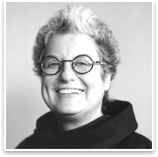
 Merrill
Elam, AIA Merrill
Elam, AIA
Summary: Merrill Elam, AIA, is a principal with Mack Scogin Merrill Elam Architects, in Atlanta. Elam is a frequent teacher and lecturer, and has taught at numerous institutions including the City College of New York, University of Toronto, University of Illinois at Chicago, Yale University, and the University of Virginia. She also has been a visiting critic at the Harvard University Graduate School of Design and SCI-Arc. With partner and husband, Mack Scogin, AIA, she received the 1995 Academy Award in Architecture from the American Academy of Arts and Letters and the 1996 ChryslerAward for Innovation in Design. Education: I went to the Georgia Institute of Technology for a BArch and Georgia State University for an MBA. Interest in architecture: I don’t ever know quite how to answer that question. I knew in high school that I was interested in architecture, maybe it was because my father was a hobbyist builder. When it came time to decide where to go to school I remember thinking that I either wanted to do fashion design or architecture, and then finally I decided that architecture would be a better education, more academic. So that’s what took me to Georgia Tech. I grew up in Tennessee and, at that time, there was not a school of architecture in the state of Tennessee, and Georgia Tech was the closest to my home. Biggest professional influence: Well, of course, Mack and I have been partners forever it seems like. We actually met in architecture school. I always tell students be careful who you hang out with. We worked together for 12 or 15 years at what’s now Heery International but then was Heery and Heery. Then in 1984, we started our firm. We’ve been working together 30 years or so, and I would say we’re just like any other long-term partnership. It’s been a long career together. Design philosophy: We talk often about—and I think a lot of other architects talk about this as well—that we like for the work to be generated out of the circumstances of the project: the personality of the client, the region that it’s in, and the place where it is. I’m not sure exactly how that relates directly to space-making, but I think we’re always looking for spaces that address the needs of the particular project. It’s going to make a different space every time, because every client and every program is different, every place is different. I would say it’s a discovery process that you go through for each project, and hopefully at the outcome there’s something unique for that particular exercise, that project. Women in the profession: I can tell you that in our office—I haven’t done the counting exactly—but I would think that we are probably running about 50/50 or 40/60 [men to women] or something like that. We’ve got a really equitable mix and we try real hard to help both the women and the men make life work when kids come along [by providing benefits like] parental leave and so on. I can’t speak for the bigger audience. I think architecture in general is a demanding profession. It’s not always easy and I think men feel that just as clearly as women. There are some very successful women architects out there, very good ones and women who just love architecture. I’m thinking about Andrea Leers and Jane Weinzapfel. They’re such a great example. I remember Andrea telling me one time, when they started their firm, that they said: “Let’s do this as long as we’re having a good time with it. If it stops being a good time then let’s stop.” And they’re still together, so it’s a good philosophy. What do you think needs to happen for the profession to achieve a level of diversity commensurate with the population? Favorite place: What’s my favorite place? How about standing in the middle of the Pantheon? That’s a good place. There are a lot of great places. Standing at the edge of the ocean, that’s another good place. Currently reading: I’m reading William Faulkner’s As I Lay Dying, and the second book I just started is The World is Flat, by Thomas Friedman. What would your dream project look like? |
||
Copyright 2008 The American Institute of Architects. All rights reserved. Home Page |
||
news headlines
practice
business
design
For more information on the work of Mack Scogin Merrill Elam Architects, visit the firm’s Web site.
